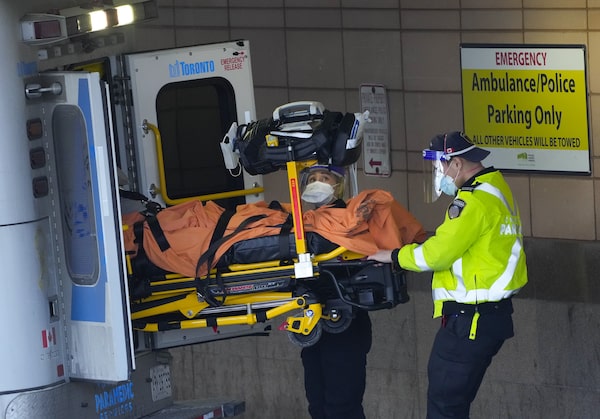
Paramedics transfer a patient out of their ambulance to the emergency department at Michael Garron Hospital during the COVID-19 pandemic in Toronto on Jan. 10.Nathan Denette/The Canadian Press
Ontario will release a plan Thursday that it says is intended to fix problems that have plagued hospitals and the health care system across the province, a “status quo” that cannot continue, the government says.
Health Minister Sylvia Jones said Wednesday that one component of the strategy, part of a broader health care approach, will be an expansion of a 911 pilot program for paramedics. The expansion would allow paramedics in more regions to respond to palliative care, mental health and addictions calls without taking patients to an emergency room, to alleviate capacity at hospitals.
The province is under pressure to come up with solutions as emergency departments and intensive-care units have faced service disruptions because of lack of staff. According to Ontario Health, 13 hospitals have had to temporarily close emergency rooms since the end of June.
The first phase of the program was launched early in 2020 and is now being used in more than 40 municipalities. For two years, paramedics treated the patients on scene or took them to, for example, a mental-health facility. Paramedics will now also be able to provide treatment onsite for diabetes, epilepsy and minor acute illnesses and injuries, such as falls.
Ontario Health Minister doesn’t rule out some privatization of health care services
Ms. Jones didn’t say in how many areas across the province the initiative, called “911 models of care,” will be expanded.
In a Wednesday address at the Association of Municipalities Ontario conference in Ottawa, Ms. Jones touched on elements of the plan, which she said will include “bold action” to address overwhelmed hospitals and nursing shortages across the province. She is slated to make an announcement Thursday with Long-Term Care Minister Paul Calandra and Ontario Health President and CEO Matthew Anderson.
“We can no longer stand by and support a status quo that cannot respond to the current challenges the sector is facing,” Ms. Jones told municipal leaders. “Our goals are clear, provide the best care possible to patients and residents while ensuring the resources and supports are in place to keep our province and economy open.”
Under the paramedic program, she said that patients are accessing care 17 times quicker and 94 per cent didn’t go to the emergency department in the few days after being treated.
At Queen’s Park Wednesday, Premier Doug Ford had a similar message when asked by the Official Opposition NDP what the government is doing to keep emergency departments open and reduce a backlog of surgeries.
“We can’t do the same status quo. The status quo has been broken. We’re going to fix it, we’re going to deliver health care in a different fashion through the sector’s advice,” Mr. Ford said.
The Premier didn’t provide details on what will be changing, but pointed to investments that his government has made in the system to address shortfalls since it took office, including $40-billion over the next 10 years on expanding hospital infrastructure.
Opinion: The first step for Ontario’s Health Minister is admitting the system is in crisis
Mr. Ford also touted the addition of more than 14,500 nurses in the province since 2018. According to data from the College of Nurses of Ontario (CNO), Mr. Ford is referencing the number of nurses registered to work in the province, but this figure also includes those not currently working in the field or on leave.
CNO’s 2022 report from July indicates that there are 155,604 nurses employed in the province, an 8-per-cent increase of 11,158 nurses from 2018. (Though the increase in registered nurses was smaller at 4 per cent.) From 2021, the number of nurses working in the province increased by just under 2 per cent.
The government said it is continuing to prioritize the registration of health care workers to address the staffing shortage, including accelerating the accreditation of those internationally trained. Ms. Jones issued directives to both the colleges of nurses and physicians to provide reports outlining how they intend to speed up the process, both of which are due Thursday.
In a statement, CNO spokesman Bradley Hammond said there are currently 10,273 active applications for international nurses seeking registration with the college in various stages of the process. Mr. Hammond said registration could happen in “as little as a matter of weeks” if an applicant has all the necessary requirements. As of June, the college accredited 3,967 international nurses this year, surpassing the annual record set in 2021.
Mr. Hammond said the college is also working on a plan that it will bring forward to the government to “reduce barriers” for non-practising nurses to return to the profession. As of July, there are 14,900 nurses registered as non-practising in the province.
The Ontario Nurses’ Association and other health care unions have been calling on the government to repeal Bill 124, which they say is needed to retain nurses in the system. The contentious legislation, introduced before the COVID-19 pandemic in 2019, caps public-sector wage increases to one per cent annually for a three-year term.
With a report from The Canadian Press
Our Morning Update and Evening Update newsletters are written by Globe editors, giving you a concise summary of the day’s most important headlines. Sign up today.
 Dustin Cook
Dustin Cook